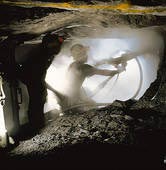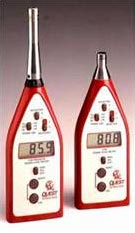Instantaneous Noise Survey and Octave Band Analysis
Field measurements must be taken in order to know how loud a piece of equipment operates or an individual's personal exposure to noise throughout a work shift. Several types of noise surveys are involved in a comprehensive noise program: an instanteous noise survey, octave band analysis, noise dosimetry, and a time-motion study. This section of instruction will cover instantaneous noise measurements and introduce octave band analysis. The following modules will discuss noise dosimetry and time-motion surveys, respectively.
Instantaneous Noise Survey
 An instantaneous noise survey is used to document the operating noise levels for each piece of equipment. This helps a mine operator define any equipment that exceeds 115 dBA (a level to which no miner shall be exposed for any period of time per MSHA) as well as identfying equipment that might result in more exposure than others (i.e., equipment to which even "passers by" would need to wear hearing protection in the "hazardous noise area").
An instantaneous noise survey is used to document the operating noise levels for each piece of equipment. This helps a mine operator define any equipment that exceeds 115 dBA (a level to which no miner shall be exposed for any period of time per MSHA) as well as identfying equipment that might result in more exposure than others (i.e., equipment to which even "passers by" would need to wear hearing protection in the "hazardous noise area").
An instantaneous noise survey can also be used to prioritize work areas for evaluation. If area measurements while operations are ongoing produce dBA noise levels at or below 80 dBA, the area can be prioritized later for evaluation. Areas where area noise measurements exceed 80 dBA and above may be prioritized earlier in the baseline evaluation process.
This survey is conducted with an instantaneous sound level meter (pictured on the right). There are many manufacturers of noise meters. The meter you purchase or rent should be a Type II Sound Level Meter set to the following parameters.
- "Slow" response
- dBA setting
- Range of 80 - 120 dBA
The instruments should be field calibrated prior to and after use to ensure accuarcy (within +/- 0.3 dB). It is also important to take the noise measurements at the operator position (i.e., the location(s) where the operator, assistant, or other worker is or would be positioned during use) while the equipment is under load (i.e., actual use with materials or substrates). Equipment is much louder and operates at different frequencies while under loaded conditions.
Octave Band Analysis
 An octave band analysis is used to define the primary frequency or frequencies in which the equipment is operating. This measurement, while not required during routine noise monitoring, is essential when considering noise control options. This measurement is more involved and will only be covered in an introductory fashion in this training format. Many sound level meters have incorporated octave band analyzers that will provide a noise measurement at a variety of frequencies, called center frequencies, in Hertz (e.g., 37.5, 63, 125, 250, 500, 1K, 2K, 4K, 8K). When noise measurements are collected with the filters "on" to limit noise to certain frequency ranges, the predominant frequency/frequencies will be represented by the highest noise levels. Many older meters require measurements collected in a "linear" mode in which a mathematical weighting must be applied by the user to determine the equivalent dBA measurement. Most newer octave band analyzers will provide the weighted, corrected value. You will need to check the noise instrument manual if completing these measurements to determine if a mathmatical weighting adjustment needs to be completed following the measurements.
An octave band analysis is used to define the primary frequency or frequencies in which the equipment is operating. This measurement, while not required during routine noise monitoring, is essential when considering noise control options. This measurement is more involved and will only be covered in an introductory fashion in this training format. Many sound level meters have incorporated octave band analyzers that will provide a noise measurement at a variety of frequencies, called center frequencies, in Hertz (e.g., 37.5, 63, 125, 250, 500, 1K, 2K, 4K, 8K). When noise measurements are collected with the filters "on" to limit noise to certain frequency ranges, the predominant frequency/frequencies will be represented by the highest noise levels. Many older meters require measurements collected in a "linear" mode in which a mathematical weighting must be applied by the user to determine the equivalent dBA measurement. Most newer octave band analyzers will provide the weighted, corrected value. You will need to check the noise instrument manual if completing these measurements to determine if a mathmatical weighting adjustment needs to be completed following the measurements.

